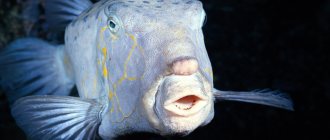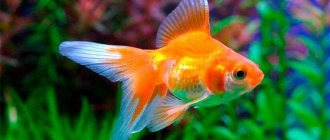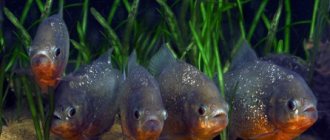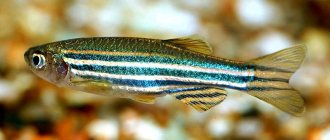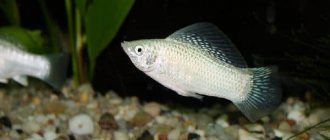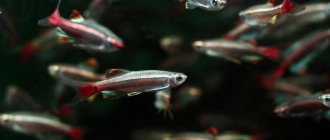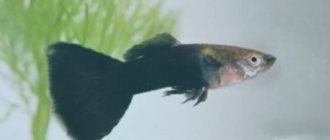Who doesn’t know a small red fish with a long appendage extending from its black tail? Of course, this is the swordtail - an aquarium fish that is incredibly popular all over the world. It gets along well with some other species, tolerates water conditions that inexperienced aquarists may suit it, and has excellent vitality. Peaceful and non-territorial, swordtails may seem like a worthless addition to an aquarium to some, but for most they are still good friends.
What do fish look like?
The habitat of swordtails is the shallow waters of Mexico and Honduras. He likes to live in thickets of grass - there is a higher probability of feeding on insects. Since in nature this fish is accustomed to feeding on small food from the surface, its mouth is positioned accordingly: raised up. Otherwise, the fish has a classic body shape with average fins. Only the lower ray of the tail is so elongated that it is shaped like a sword. This makes the fish unique. The tail sword gave the fish its name in both Russian and Latin.
The size is not as small as we are used to seeing: it can reach 10 cm in length, not counting the sword. When it comes to color, there is a lot more variation than just bright red.
general characteristics
Thanks to their appearance, you can immediately determine that swordtails are “relatives” of platies, and this is not surprising, since both types of fish belong to the platies family. In nature, these lovely creatures live in the reservoirs of Central America, as well as Mexico. In terms of color, this fish initially has an exclusively green color, and the usual red tint is an artificially bred color. Experienced breeders have discovered that red platies cross well with swordtails. Thanks to this, various shades were developed, the number of which is increasing every day.
Many people are interested in swordtails due to their amazing features. The fact is that these fish, unlike many others, are capable of changing gender. So, if an aquarium accidentally contains all females, then under such stressful conditions some of them can grow a sword and, accordingly, become males. Thanks to this, it is possible to produce offspring, but, as practice shows, such couples produce only females.
In nature, swordtails, of course, grow larger than in aquarium conditions. Females are slightly larger and larger, growing up to 13 cm, males - no more than 10 cm. Even the most inexperienced beginner can distinguish individuals by gender. Males are distinguished by a long, sword-shaped appendage on their tail. Breeding forms may even have several swords.
The natural color of swordtails is gray-olive, with longitudinal reddish stripes along the body. In males they are more noticeable. If we talk about mixed species, their stripes can be very different. For example, yellow, bright gold, red, black, etc.
Varieties of swordtails
The natural color is not scarlet at all. The main color is green with transitions to pearlescent olive. It has several longitudinal red stripes from head to tail. The sword is olive, edged with black. Males are richer, females are paler.
There are also such color solutions:
- Albino and white Bulgarian are variants of natural green, only the main color is white.
- Ruby is also a natural color, the result of natural selection.
- Black - the body is black, the fins are yellowish-white. A hybrid variant of crossing a swordtail and a platie. Difficult to reproduce.
- Red is also a mixture of swordtail and platy. But in the previous version, black platylia was used, and in this case, red. The body of these fish is completely scarlet.
- Koi, calico, kohaku and santa claus are different species of swordtail, the color of which resembles the color of koi carp - tri-color koi, chaotically spotted kohaku and two-color (red and white) santa claus.
- Tiger is one of the species familiar to us. Red back and sides, and more and more black appears closer to the tail. The tail is black.
- Berlin is another incredibly popular color in domestic aquariums. The red body is combined with a black tail.
There are options with even more unusual fins.
- Lyretail - has an atypical shape of the caudal fin: it has the shape of a crescent. The body color varies, but the tail is usually black.
- Flag swordtail - the dorsal fin of this beauty looks like a sail or flag, and attracts attention much more than a sword.
- Forked - the tail seems to consist of two swords; not only the lower, but also the upper ray of the tail is elongated.
- Cuban - the dorsal fin is no less luxurious than the flag one, and the color is black and red.
Maintenance and care
As mentioned above, the swordtail can withstand many of the challenges that befall fish in the “my first pets” category. Sooner or later, a person understands whether he wants to create truly comfortable conditions for the residents of the aquarium, or whether aquarium farming is not his occupation. What conditions help swordtails live long and not get sick? You will be surprised, but:
- The volume of the aquarium is from 50 liters for three fish (male and two females). It is better to plant part of the aquarium with long-leaved and broad-leaved plants. There must be room for swimming. Swordtails do not need shelters (grottoes, burrows, pipes).
- Temperature 21-25°C
- Hardness 6-20° (soft)
- Acidity 7.5 (neutral environment)
- Weekly water changes
- You need to siphon the soil 1-2 times a month
- Well-established filtration and aeration
- The aquarium must have a lid.
How long will swordtails live if their maintenance and care are close to these conditions, and not to what conditions are necessary? Up to 5 years. This is an average figure in the aquarium world, but for swordtails it’s quite good.
Habitat
This species is native to Central America. The original natural range extended from Mexico to Honduras. The fish inhabited numerous river systems flowing into the Atlantic Ocean.
Nowadays, due to the fault of aquarists, the distribution area has increased significantly. Swordtails can be found on almost all continents (with the exception of Antarctica) in the tropical and equatorial climate zones.
Brief information:
- Aquarium volume - from 100 liters.
- Temperature - 16–28°C
- pH value – 7.0–8.0
- Water hardness - from soft to high (10–30 dGH)
- Substrate type - any
- Lighting – moderate or bright
- Brackish water - salt concentration up to 15 g per 1 liter is acceptable
- Water movement - weak to moderate
- The size of the fish is 14–16 cm.
- Food - any food
- Temperament - peaceful
- Living alone, in pairs or in a group
Feeding swordtails
These are unpretentious fish in terms of food, you can safely switch them to dry food. It is especially good if the choice falls on high-quality food: it does not clog the aquarium and uneaten remains do not poison the water with nitrates. The main thing is that the food remains on the surface of the water as long as possible. Special flakes are designed specifically for fish that feed on the surface of the water.
If you are ready to feed bloodworms or tubifex, this is very good, since swordtails treat live food with more love, they grow faster on it and are less susceptible to disease.
Where do swordtails live?
You can meet swordtail fish in the wild in Central America, Africa, and India. They are also found in Great Britain, but there aquarists themselves had a hand in their spread, releasing them into wild bodies of water.
Swordtail fish live in a variety of bodies of water: from fast mountain rivers to lakes and swamps. The main condition is the presence of abundant vegetation.
Compatibility and behavioral characteristics
In general, the swordtail is considered a peaceful fish. But intraspecific conflicts between males are quite typical. Males can be aggressive, especially at the age of puberty. Usually in one aquarium they keep two females for one male. But if there are several such harems, the owner will be able to watch the fights of the males, even if the territory is large and there is enough space for everyone. This is the nature of swordsmen.
As for compatibility with other species, platies, ternets, tetras, zebrafish and any catfish are often prescribed as neighbors to swordtails. The main thing is that neighbors:
- Were not aggressive fish
- Were not predators
- They didn’t like to pinch their neighbors’ fins, otherwise the swordtails risk being left not just without a sword, but without an entire tail
- They themselves didn’t have too much of a “veil”, because swordtails also don’t mind nipping other people’s tails
The difference between a female and a male
The swordtail is a mysterious fish, since the male and female, as a rule, can be distinguished by the tail process, but in certain situations the fish can easily change gender, growing or shedding a “blade” and replacing the genitals.
There are two features that can be used to distinguish a male from a female: the caudal process and the anal fin.
The male always has with him a large tail growth, which can reach the length of the body. Although females grow similar “blades,” they are several times smaller. The female most often does not grow a “sword”, so distinguishing her from the male is not difficult.
As for the anal fin, in the male it is elongated into a tube, and in the female it is rounded. This structure is not accidental, since the male uses the fin to fertilize the female.
However, all arguments related to gender are sometimes meaningless, since fish, being surrounded by a large number of “relatives,” can change gender at will.
This feature causes big problems for both sellers and aquarists, since if you buy, for example, three females and one male, you can end up with three males and one female.
Males, as a rule, defend their territory and compete with each other, therefore, after such metamorphoses, the calm aquarium life can be interrupted by “gladiator competitions”, which will disturb all “tenants”.
For this reason, we recommend buying either a large “flock” at once, which will number about ten individuals, or taking only a couple.
However, even this option does not exclude the fact that all fish can become males or females.
Did you know? The female, who after metamorphosis has become a male, lays down material at the genetic level that affects the number of female individuals. As a result, up to 90% of “girls” are born.
How to determine gender
When it comes to swordtails, the question of how to determine the sex of fish has a simple answer. Males are brighter than females and have a sword on their tail. Females are paler and their tail does not have elongated rays. For those species that do not have a sword, the first rule is relevant: females are noticeably paler and more unsightly than males.
Sexual maturity occurs at approximately six months of age. From this period, fry may appear in the general aquarium. If the fish find the living conditions suitable, offspring will appear regularly. A once fertilized female can give birth to 50-100 fry for several months in a row with a frequency equal to the gestation period.
A pregnant female swims for 4 to 6 weeks. This period depends mainly on the water temperature. Before giving birth (which usually happens at dawn), she begins to swim especially restlessly, after which the fry are born. If an aquarist wants to preserve offspring, he will have to take care of the young. They can be left in a general aquarium, but provided with plenty of reliable hiding places in the form of dense vegetation. It is necessary to ensure that producers do not see the offspring, otherwise they will be regarded as food.
Special manipulations - cooling or heating the water, feeding with special food, shading or brightening the space - are not required for breeding swordtails. The main thing is that living conditions are close to ideal, then the reproduction process will start by itself.
Diseases of swordtails
These fish begin to get sick under catastrophically unsuitable conditions. In general, these are fish with very strong immunity; hybrids have slightly weaker health. Common fungal aquarium diseases also apply to swordtails, however, sometimes it happens that other fish get sick, but these remain healthy. In the treatment of any disease, the main thing is timely and correct diagnosis. Medicines (methylene blue, brilliant green, costapur, bactopur, etc.) are tolerated quite easily.
The swordtail is an unpretentious resident of any aquarium of sufficient volume. Don’t forget to watch your fish, study their habits, characters, and preferences. The aquarium is there to enjoy it and learn to be better.

